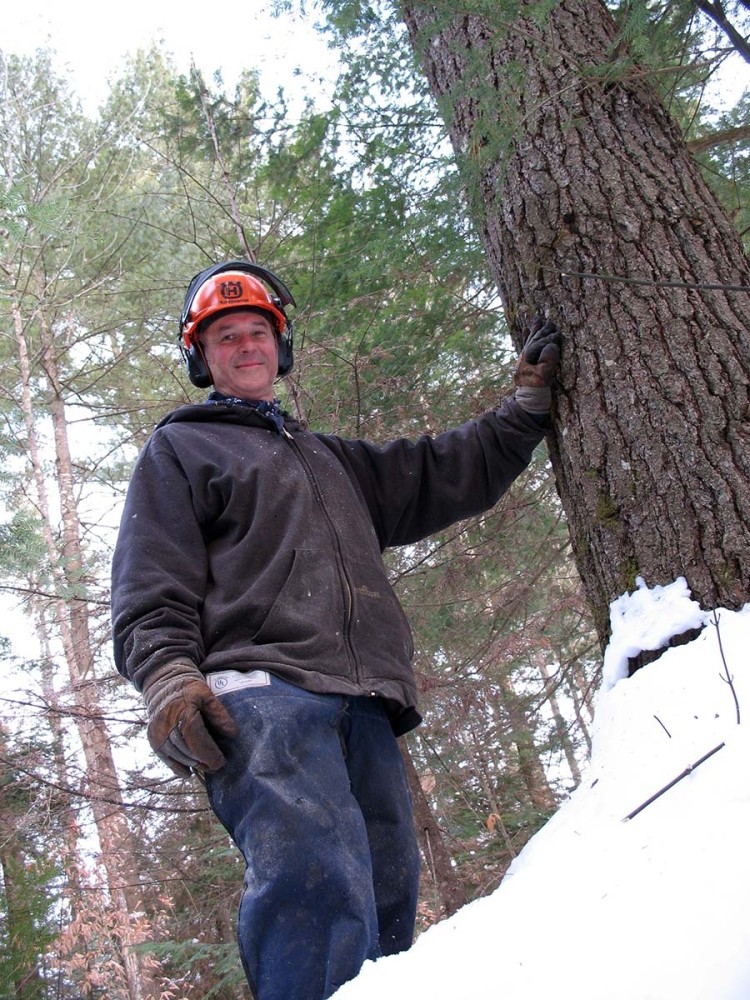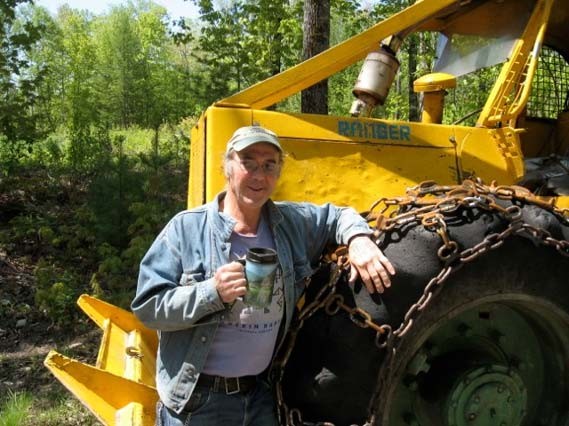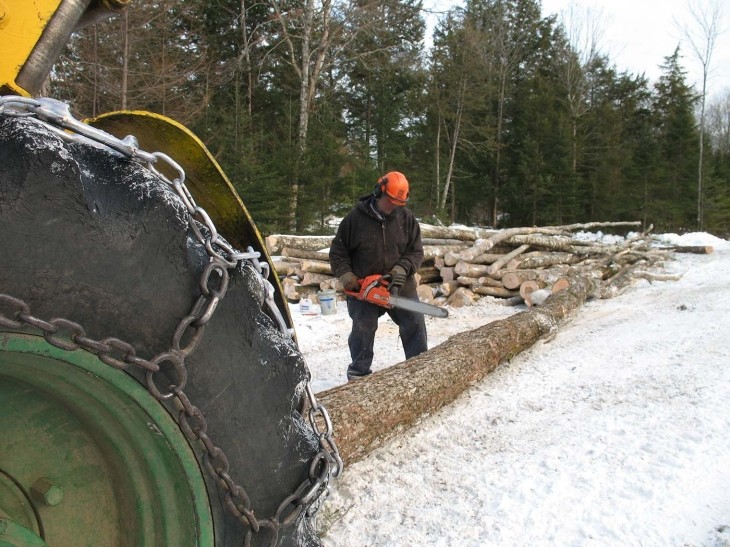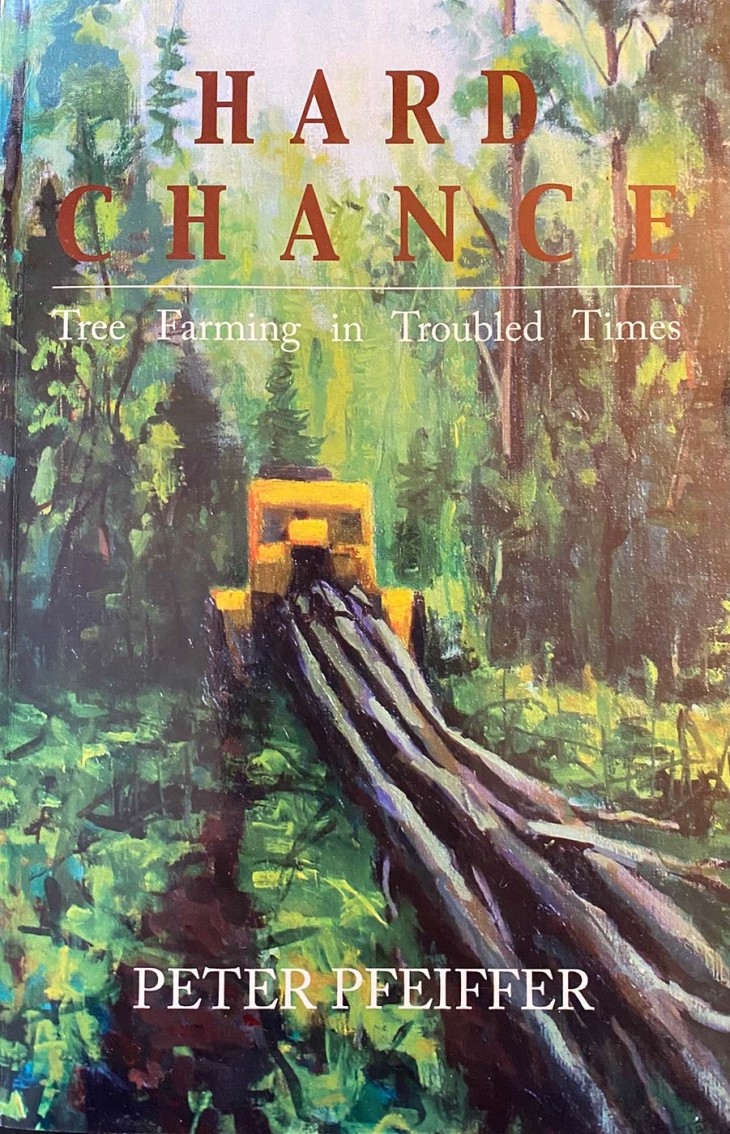Peter Pfeiffer has been working in the Maine woods with a chainsaw since 1974, often on his 113-acre woodlot in Solon, where he lives off the grid, relying on solar and wind power for electricity. He’s traveled extensively, been a Boston cab driver, and actively participated in community theater – including with Maine’s storied In Spite of Life Players. He’s twice been named the Somerset County Tree Farmer of the Year, and in 2018 he was named the Certified Logging Professionals Logger of the Year. His book, Hard Chance: Tree Farming in Troubled Times, published in 2014, shares Peter’s reflections on his decades of working in the woods.
I grew up in Waterville, Maine, and in those days, we were outside every chance we got, playing in the snow or mud, building forts and tearing around on our heavy one-speed bikes with what might have been thousands of dollars worth of baseball cards sputtering in the spokes. Waterville was thriving. Every store on Main Street was open for business, the schools were good, the countryside was just outside the back door, we had skiing and skating and all kinds of sports. It was kind of like a Norman Rockwell painting. My brother and I considered it about the best place to grow up you could possibly want.
By far my favorite woodlands memory is of a summer-long canoe trip down the Allagash in 1962. We saw more moose than people. The trip was led by two old Maine guides. They were probably in their 60s anyway, and I was 13. There were 20 13-year-olds, which looking back seems a little reckless. There were no cell phones in 1962, and there was nobody in those woods. We’d canoe for a while and then we’d set up camp and swim and fish. About once a week an airplane would meet us and drop off supplies. There were a couple of forest fires that we helped put out. One started by lightning, a big pine tree caught fire right next to the camp. All these 13-year-old boys formed a bucket brigade and were throwing buckets of water on this raging forest fire.
That was all Great Northern land, one of the big paper companies. The whole trip we were going by these log booms with wood floating, and there were tugboats hauling logs here and there. There was a herd of work horses resting up during the summer, just loose in a field by one of the lakes, and so we all jumped on those and galloped around. I have no idea how a 13-year-old kid can get on a one-ton horse, but I remember hanging on for dear life. It was a formative experience. I just loved the whole thing. I loved the woods. I loved the smells. I didn’t care for the bugs of course, but everything else about it was just wonderful.
I got out of college in 1969, which was of course a very fractious period in American history. I was looking around for something to use my sociology and theater degree on, and nothing came up, so I got a job as a cab driver in Boston. I drove the cab 12 hours a day 7 days a week, but I was making 50 or 60 dollars a day, which was pretty good money in those days, so I ordered a BMW motorcycle from a factory in Munich and went over there in March. Who knew it was still winter in the Alps in March? I went over the Alps and through Austria and down into Italy and down the Yugoslavian coast, snow and rain most of the way. I got to Greece, and I was going to go to East Africa by way of Egypt, but people said, “You can go to Israel and get a job on a kibbutz.”
I didn’t really know what a kibbutz was, and the whole idea of Israel was pretty vague to me, but I went over there and started working on the kibbutz. I loved living on a communal enterprise like that and picking pears. I was up in the Upper Galilea, between Lebanon, Syria, and Jordan. There wasn’t a war going on in 1970, but there was a lot of shooting and rockets and fighting, just as a matter of daily events. I stayed on the kibbutz for a few months, then I went back to driving a cab in Boston and eventually back to Maine, where some friends of mine had bought an old farm outside of Waterville and set up a left-wing commune. That went for a little while, and then I got my own place further north, and that’s where I’ve been ever since.
I bought this place in 1973 from an old man, Mr. York, and moved here in ’74. Mr. York was born in 1880. He married his wife when he was 17 and she was 15, and they were married for over 70 years. He had amassed thousands of acres over the years, although you wouldn’t have guessed it to see their circumstances. He just loved to talk about the old days, and I loved to listen, about how everything used to be at the turn of the century and up through all those really hard years, working during the Depression for a dollar a day and walking for miles to get to work and living on venison and potatoes. It took me a couple of years of visiting him before he would relinquish a woodlot to me. But finally his wife – she’d had a leg amputated for diabetes, and Mr. York was pretty much blind – she said, “You know, Herbert, I don’t think you’re ever going to build a camp on that piece of property, why don’t you sell it to Peter?” So, he did.
I bought these 80 acres, and I was able to add some adjacent property, so now I have 113 acres. I got an old farm tractor, and I cut some fir logs to have sawed out to build a house. I loved it. It’s a very bruising learning experience. I had no idea what I was doing. Trees were falling every which way. After we got the house built, that summer I was looking for a job, and the only job there was, was cutting wood for Scott Paper Company. At the time, it was 4-foot wood, which is what it sounds like – you cut the logs into 4-foot chunks and pile them up with a pulp hook, and then a machine would come by and carry them up to the road.
It was pretty back-breaking work, and it was an hour or more on dirt roads up into a place called Misery Ridge, which was aptly named. The wind was howling, and it was snowing. One time over Christmas it just rained, and everything flooded, and all my wood floated and then froze. So I quit and got a job closer to home, cutting 4-foot wood on my own. I bought stumpage off an old farmer.
Logging, as you know, comes and goes. It’s seasonal, and the market changes. But the nice thing about logging, at least as a small, independent guy, is you can fit it into a mosaic of other jobs. You can always set it down and go off and do something else when times require it. I’ve always had a backup as a carpenter. I was always traveling, too. I’d go to Colorado and work on a ranch or to Florida and work on a shrimp boat or to Nantucket to work as a carpenter.
I’ve never worked indoors in my life. I can’t imagine going to an office or having a boss or anything. After a while you get sort of trapped into this way of life of doing things your own way. I started working in the woods in 1974. I started off using an old farm tractor, then I bought a worn-out skidder, and that broke down finally. Then I bought a better one. And that’s my only investment. That and the saws. So, I’m pretty footloose.
I have developed a system of harvesting I call the “patch cut,” or “checkerboard” method in which I work certain areas each year, harvesting in the winter, and then returning in the spring to re-plant and/or thin and weed. I have taken over 5,000 cords of wood off this place and there is still a beautiful forest of valuable timber growing, with a healthy stock of wildlife living in its midst. And I have worked on 20 or 30 other woodlots in the neighborhood, oftentimes more than once.
When I started, there were some 7,000 chainsaw loggers in the state, and now there are only a few hundred. Those work horses we saw on our trip down the Allagash were replaced by skidders, which were replaced by mechanical harvesters, grapple skidders, de-limbers and chippers. Mechanical operations are far safer, and incomparably more productive. But they require around a million dollars in initial investment, depending on how new the equipment is.
There’s been a rapid change from harvesting timber into harvesting fiber. By that I mean that chainsaw operators have to work with large, individual trees, the butt logs off of which went for lumber, and the tops went for paper pulp. Mechanical harvesters, on the other hand, can mow down anything they can get a claw around, right down to alders. They can do an excellent job of selective cutting, if that’s what the landowner requires, but much of the woodlands in Maine are being ruthlessly stripped, and stripped again before they can re-grow into what you would recognize as a forest.
There is just a natural process in American business where you move toward bigger machinery and eliminate hand work. It happens in farming and fishing and mining and everything else. If there’s a machine that can do the job of 10 or 100 men, that’s the direction you’re going to go to. Modernizations can be devastating, not just for the individuals who suddenly find themselves obsolete, but entire regions go into decline when industries are shut down. Many formerly bustling towns in northern Maine now look like ghost towns.
The other long-range problem is soil degradation. One can imagine how whole tree chipping removes all the material and leaves nothing to replenish the already very thin northern soil. This is particularly true when you have enormous grapple skidders hauling huge twitches of trees with all their branches, more or less wire brushing the topsoil when it’s not frozen and/or protected by snow. That said, some mechanical crews use a de-limber in the woods, and a forwarder to haul out cut-to-length logs on what is essentially a big truck on tracks.
I want to make it clear that the guys who are running these harvesters can do a really nice job of selective cutting. I’m not trying to set myself as opposed to them in any way. They can pick trees up and lay them in the road, so you don’t have to scuff up the surrounding woods or flatten then young growth. It’s just that they have to keep going. They need so much acreage just to pay for these machines. So, we’re going in different paths. I have a lot of respect for all my comrades working in the woods.
Chainsaw logging is and always has been really dangerous, from getting struck or cut and also just wearing out. I’m recovering from a knee replacement now, but I’ve had back surgery and ankle surgery and shoulder surgery and hip surgery. Everybody I know who’s done it is more or less a cripple. It got a lot better after the CLP (Certified Logging Professionals) program. When I started, one out of four guys ended up in a hospital, and I think worker’s comp was almost as much as a guy’s wages.
The CLP program was a real game changer. They turned logging into a science. We were sort of forced into it at the time. Everybody was a little grumpy about it because we thought, “Well, we’ve been out cutting wood. We don’t need to have some fancy pants guy from Sweden tell us how to cut down a tree.” But it turned out to be the best schooling I ever had. It was a five-day course, and we went into the woods and learned these new techniques for cutting down trees that were much safer. And we studied the economics of the situation. I remember one young fella saying, “Whaddya mean we should keep track of the money? I love logging so much, I don’t want to know if I’m making money or losing it!” I think he voiced the feelings of a lot of us.
A chainsaw is probably the most dangerous tool readily available to any homeowner. I would urge anyone who intends to go into the woods for any reason with a chainsaw to take a CLP-style course on chainsaw safety and invest in the protective gear like a helmet, chaps, and boots. I have often heard people say, “Oh, I just cut a little firewood,” as if that will somehow protect them from injury. It won’t.
There’s intrinsic value in a woodlot. I am an advocate of small time tree farming. I believe that a properly managed woodlot can provide firewood, pulpwood for cash money, and/or timber both for sale or for building projects. This is particularly true nowadays when there are lots of efficient portable sawmills which can turn a wide variety of trees into a wide variety of valuable building materials. I think we can learn from the past when every family farm had a woodlot for seasonal work to generate cash, fuelwood, and building materials.
If I had to choose my favorite place, it would be right here. I have a beautiful beaver pond right in the center of my place. That’s why Herbert York loved this place. The beaver pond is a couple of acres, and the beaver dam is maybe 150 feet long and 8 feet high. It’s been there for a long time. It was there when Herbert York was a kid. There’s moose and deer and blue herons and the occasional eagle and beavers and muskrats and foxes.
I love motorcycling around and going up on ridges and mountain tops and looking out. Even though the woods have been cut pretty hard, you still have the sense of being out in the wilderness. I’m on my sixth or seventh BWM bike. It’s a great big monster. I’m looking for BMW to come up with an electric bike. Then I could just drive it and come home and park it next to the solar power and wind power and not have to buy gas for it. I’ve always liked BMWs. I’m not smart enough to drive a Harley – you have to be a really good mechanic to keep those going. BMWs you just get on them and drive around and park them and forget about them.






Discussion *